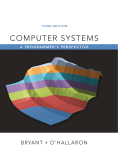
Explanation of Solution
Function definition for “float_i2f()” function:
The implementation for “float_i2f()”function is given below:
//Header file
#include <stdio.h>
#include <assert.h>
#include <limits.h>
//Declare the float_bits in unsigned data type
typedef unsigned float_bits;
//Function declaration for float_i2f function
float_bits float_i2f(int i);
//Function definition for compute the bit length
int findBitsLength(int i)
{
//Check bit length
if ((i & INT_MIN) != 0)
{
//Returns value "32"
return 32;
}
//Assign the unsigned number
unsigned unum = (unsigned)i;
//Initializes the length is "0"
int len = 0;
//Check the length
while (unum >= (1<<len))
{
len++;
}
//Returns the length
return len;
}
//Function definition to generate mask
unsigned findBitsMask(int bl)
{
//Returns the bits mask
return (unsigned) -1 >> (32-bl);
}
//Fnction definition for compute (float)i
float_bits float_i2f(int i)
{
//Declare variable
unsigned signBit, exponentBit, fractionBit, remainingBit, exp_signBit,rp;
//declare variable bits and float bits
unsigned b, fb;
//Assign bias value
unsigned biasValue = 0x7F;
//If "i" is "0", then
if (i == 0)
{
//Assign all bits to "0"
signBit = 0;
exponentBit = 0;
fractionBit = 0;
//Returns the value
return signBit << 31 | exponentBit << 23 | fractionBit;
}
//If "i" is "INT_MIN", then
if (i == INT_MIN)
{
//Assign given value to each bit
signBit = 1;
exponentBit = biasValue + 31;
fractionBit = 0;
//Returns the value
return signBit << 31 | exponentBit << 23 | fractionBit;
}
//Assign sign bit is "0"
signBit = 0;
/* For two's complement */
/* If "i" is less than "0", then */
if (i < 0)
{
//Assign sign bit to "1"
signBit = 1;
//Assign "i" to "i - i"
i = -i;
}
/* Compute bits length by calling function "findBitsLength" */
b = findBitsLength(i);
//Compute float bits
fb = b - 1;
//Compute exponent value
exponentBit = biasValue + fb;
//Compute remaining bit value
remainingBit = i & findBitsMask(fb);
//If "fb" is less than "23", then
if (fb <= 23)
{
//Assign fraction bit and except bit value
fractionBit = remainingBit << (23 - fb);
exp_signBit = exponentBit << 23 | fractionBit;
}
//Otherwise
else
{
//Compute offset value
int offsetValue = fb - 23;
//To find round middle value
int rm = 1 << (offsetValue - 1);
//For round part
rp = remainingBit & findBitsMask(offsetValue);
//Assign fraction bit and except bit value
fractionBit = remainingBit >> offsetValue;
exp_signBit = exponentBit << 23 | fractionBit;
/*Check if it is round to even */
if (rp < rm)
{
}
//If round to odd, then
else if (rp > rm)
{
...
Want to see the full answer?
Check out a sample textbook solution
Chapter 2 Solutions
EBK COMPUTER SYSTEMS
- what is a feature in the Windows Server Security Compliance Toolkit, thank you.arrow_forwardYou will write a program that allows the user to keep track of college locations and details about each location. To begin you will create a College python class that keeps track of the csollege's unique id number, name, address, phone number, maximum students, and average tuition cost. Once you have built the College class, you will write a program that stores College objects in a dictionary while using the College's unique id number as the key. The program should display a menu in this order that lets the user: 1) Add a new College 2) Look up a College 4) Delete an existing College 5) Change an existing College's name, address, phone number, maximum guests, and average tuition cost. 6) Exit the programarrow_forwardShow all the workarrow_forward
- Show all the workarrow_forward[5 marks] Give a recursive definition for the language anb2n where n = 1, 2, 3, ... over the alphabet Ó={a, b}. 2) [12 marks] Consider the following languages over the alphabet ={a ,b}, (i) The language of all words that begin and end an a (ii) The language where every a in a word is immediately followed by at least one b. (a) Express each as a Regular Expression (b) Draw an FA for each language (c) For Language (i), draw a TG using at most 3 states (d) For Language (ii), construct a CFG.arrow_forwardQuestion 1 Generate a random sample of standard lognormal data (rlnorm()) for sample size n = 100. Construct histogram estimates of density for this sample using Sturges’ Rule, Scott’s Normal Reference Rule, and the FD Rule. Question 2 Construct a frequency polygon density estimate for the sample in Question 1, using bin width determined by Sturges’ Rule.arrow_forward
- Generate a random sample of standard lognormal data (rlnorm()) for sample size n = 100. Construct histogram estimates of density for this sample using Sturges’ Rule, Scott’s Normal Reference Rule, and the FD Rule.arrow_forwardCan I get help with this case please, thank youarrow_forwardI need help to solve the following, thank youarrow_forward
 C++ for Engineers and ScientistsComputer ScienceISBN:9781133187844Author:Bronson, Gary J.Publisher:Course Technology Ptr
C++ for Engineers and ScientistsComputer ScienceISBN:9781133187844Author:Bronson, Gary J.Publisher:Course Technology Ptr C++ Programming: From Problem Analysis to Program...Computer ScienceISBN:9781337102087Author:D. S. MalikPublisher:Cengage LearningCOMPREHENSIVE MICROSOFT OFFICE 365 EXCEComputer ScienceISBN:9780357392676Author:FREUND, StevenPublisher:CENGAGE L
C++ Programming: From Problem Analysis to Program...Computer ScienceISBN:9781337102087Author:D. S. MalikPublisher:Cengage LearningCOMPREHENSIVE MICROSOFT OFFICE 365 EXCEComputer ScienceISBN:9780357392676Author:FREUND, StevenPublisher:CENGAGE L- Programming Logic & Design ComprehensiveComputer ScienceISBN:9781337669405Author:FARRELLPublisher:Cengage
 EBK JAVA PROGRAMMINGComputer ScienceISBN:9781337671385Author:FARRELLPublisher:CENGAGE LEARNING - CONSIGNMENT
EBK JAVA PROGRAMMINGComputer ScienceISBN:9781337671385Author:FARRELLPublisher:CENGAGE LEARNING - CONSIGNMENT Microsoft Visual C#Computer ScienceISBN:9781337102100Author:Joyce, Farrell.Publisher:Cengage Learning,
Microsoft Visual C#Computer ScienceISBN:9781337102100Author:Joyce, Farrell.Publisher:Cengage Learning,





